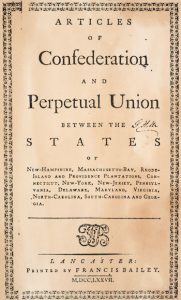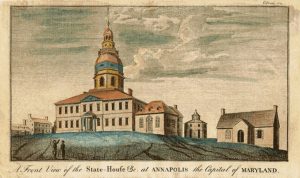Ten years after the Declaration of Independence in 1776, a small gathering in a Maryland tavern in Annapolis would change the course of American history. This ‘Annapolis Convention’, officially titled: ‘The Meeting of Commissioners to Remedy Defects of the Federal Government’, laid the groundwork for the United States Constitution we know today. The date was September 11th – 14th, 1786.

The Context
Under the Articles of Confederation, the first constitution of the United States that was activated in 1781 after Maryland ratification, America was struggling. States acted more like independent countries than members of a union. The states were on the brink of economic disaster; and the central government had little power to settle their quarrels. Disputes over territory, war pensions, taxation, and trade threatened to tear the country apart. States created their own trade barriers, printed their own currency, and often refused to honor agreements with other states. Commerce was in chaos, and the national economy was suffering.
Notably, George Washington, now retired at Mt. Vernon, was deeply concerned about the Articles of Confederation’s lack of power in the central government, particularly its inability to maintain a strong military. He believed that the fledgling nation was vulnerable. Washington strongly advocated for a revision of the Articles to create a stronger federal government. Consequently, James Madison, called for a meeting to discuss interstate commerce regulations. At first, the goal was straightforward: create uniform trade rules among the states to strengthen the American economy. All thirteen states were invited to send delegates to Annapolis, Maryland.
Perhaps as a consequence of this turmoil, eight states failed to send any representatives, and some delegates were still en route when the meeting began; the small number of participants made it impossible to achieve the original economic objectives:
- New York: Alexander Hamilton and Egbert Benson
- New Jersey: Abraham Clark, William Houston, and James Schureman
- Pennsylvania: Tench Coxe
- Delaware: George Read, John Dickinson, and Richard Bassett
- Virginia: Edmund Randolph and James Madison

The Realization
Meeting in the old Senate Chamber of the Maryland State House in Annapolis, Maryland, the delegates quickly realized they faced a deeper ailment: the fundamental political weakness of the Articles of Confederation. The delegates, particularly Hamilton and Madison, recognized that a true ‘Constitution’ was needed. Rather than making futile attempts to patch up trade relations, the delegates made a bold move. Hamilton drafted a report calling for a new convention with a broader mandate. This report, known as the ‘Annapolis Report’, recommended a meeting in Philadelphia to address not just commerce, but all the defects of the federal government.
‘….render the constitution of the Fœderal Government adequate to the exigencies of the Union….’
So what seemed like a failed trade conference, actually became the catalyst and mandate for the Constitutional Convention of 1787 – the meeting that drafted our Constitution. The Annapolis Convention’s call for reform gave political momentum to those who wanted to completely overhaul and strengthen the American system of government.
